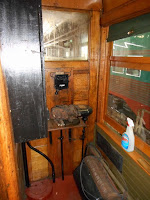Today was another busy day at the Museum. I probably missed several things, but here's a quick report on several different activities. First of all, I wanted to pull all four cars out to check things out in preparation for service this weekend, and to switch the order of the two trains.
But once I had got the 36 and 309 outside and backed them onto 83, I realized this wasn't going to work within the limits of Yard 8, due to various things blocking the tracks I usually use. Suddenly it seemed like more effort than it was worth, so I put the train back into the barn. We'll take care of this Saturday morning. But first, some pictures of the interiors:
The 308 and 319 were tested and checked in place. All compressors were checked, I made sure each end of each train has two red flags, the headlights will be ready for Sunday evening, etc.
Tim wasn't out today, as he usually takes Wednesday off, but here's what the 24 looks like inside. It should be ready for its big debut by Members' Day.
The other main activity today was helping Pete Galayda with the Charles City Western engine. We started by retesting the control system with a light box across the open motor switch. (This is something we should have done last week.) The results were as expected: the lights don't light until the fourth point. We then got out the megger and checked the continuity through the grids. Several changes to the wiring had to be made, which Pete did efficiently.
We did some more testing, and found one more change that had to be made. It also was evident that the parallel points weren't working at all. I guessed that this was due to the motor cutout interlock I had worked on last week, so I went into the hood and reset it by hand. After retightening the grid connections and checking with the megger, we tried sequencing with the light box. Everything appeared to work, so we're probably ready for operational testing again. After throwing the reverser back and forth a few times, the parallel points went dead again, but this has to be because the interlock is mounted on the reverser, and must have come loose again. I'll have to come up with a system to keep it closed. Anyway, the locomotive should now be operational. We hope.
The contractors were hard at work on this section of Central, digging out the old material.
Jeron Glander and Bob Olson were busy running the ballast train.
The ballast cars get loaded from this pile of rock near the steam leads.
Then the train is run out to Yard 15, where the ballast is dumped. By the end of the day, all of the new tracks, 151 and 152, had a layer of ballast. Tamping will come next, I suppose.
Out by Barn 14, Jon Fenlaciki is loading up seats from the North Western bilevels to take to our seating company to be redone. This is the same company that did the 65 and the 972, and will probably do the Electroliner when the time comes.
In Barn 11, Victor and Bill were working on the Pennsy bobber. I did more cleaning in the 321.
Gregg Wolfersheim was working on installing parts on the 972, which is very close to being operational. Only a few more adjustments to the brake system remain to be done, we believe.
Max is replacing poles near the diner.
By the end of the day, new material was tamped down near the Central Ave. crossing.
Lorne Tweed was working on windows for the Cleveland PCC, which can be rather frustrating at times. He wants me to point out that Eric Lorenz has been doing most of the work, and has been doing a lot on the control position, as seen above.
And what did I miss? John Arroyo and Ed Oslowski were working on the Liner, as usual. Gerry Dettloff and John Faulhaber were working on the 810. John McKelvey was doing upholstery. And probably more.
Landscaping has been done around the posts for the Santa Fe sign. I should point out that this is quite striking as seen from the road. Even though it's not on top of a ten-story building, it makes an immediate impression. In fact, it almost looks like this is now the Santa Fe Railroad Museum. I don't think anybody has a bigger Santa Fe locomotive than ours, at least.




























5 comments:
Something I never noticed about the 24 before is that the control and brake positions are reversed. The Key System bridge units were that way also I believe.
Car 1 has the same arrangement. I am unable to find any pictures of a wood car cab right now, but I think the others have the more usual arrangement of the controller on the left. At least it's immediately obvious which is power and which is brake, unlike the 4391.
Santa Fe All The Way!
The IRM construction crew deserves high praise for how the the Santa Fe sign project turned out.
Truly outstanding.
The north side 'L' built all of their early motor cars with left-hand cabs. Those cars had the controller on the right. It appears that the Lake St. 'L' did the same. IRM car 1268 rebuilt as a control trailer has a right-hand cab with the controller on the left. 1797 & 1808 were both rebuilt into motor cars from the same class as 1268, and they too have right-hand cabs with the controller on the left. Car 1754 had a left-hand cab, but was rebuilt with 4000 (Plushie) controls, and converted to right-hand cab during the rebuild. 24 is our only RT car with a left-hand cab.
Bill Wulfert
Thanks, Bill. At least I got something about the L cars right for a change.
Post a Comment